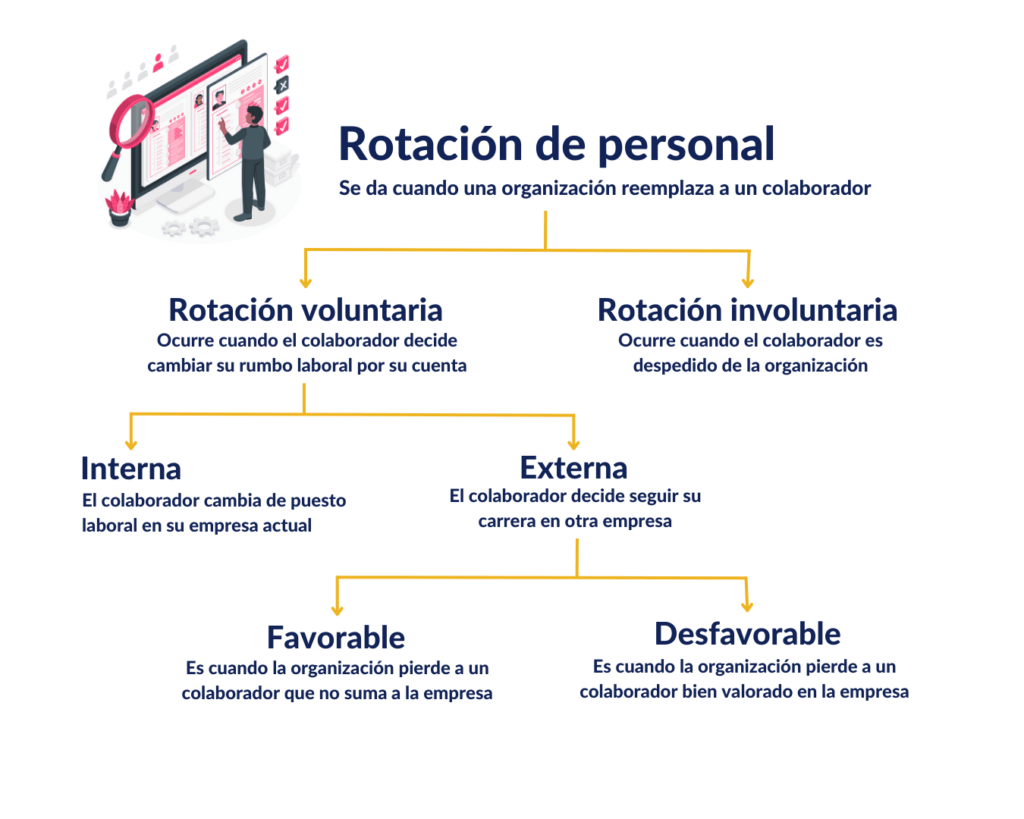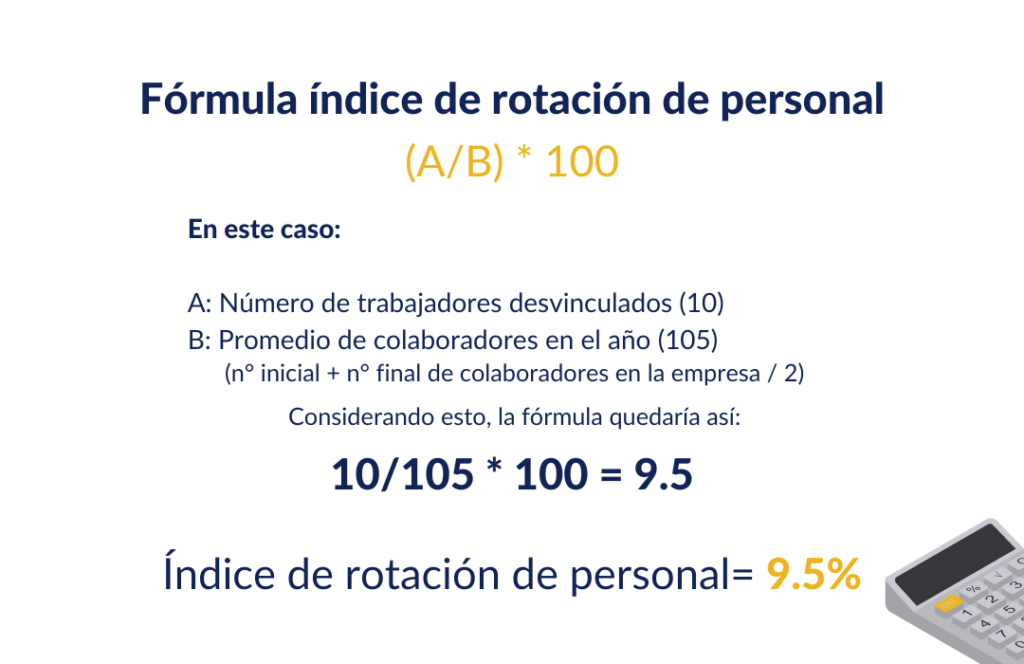Personnel turnover: everything you need to know

Measuring personnel turnover in your organization will help you correctly monitor the exit and entry process of collaborators. This process is very relevant to the company as it could affect the productivity, work environment and even the personal life of your workers.
What is staff turnover?
Personnel turnover is the process that occurs when an employee leaves a company. In simpler words, personnel turnover is when one person leaves and another enters an organization., generating movement in it. That's where its name comes from: “rotation”. This can arise due to different causes, and depending on these, they are classified in two ways: voluntary or involuntary:
involuntary rotation
Involuntary rotation is one in which the employer decides to end its relationship with the employee..
Voluntary rotation
Voluntary staff turnover is that which occurs when an employee decides to leave their current job on their own.. This can be external or internal. The external one is when the worker changes jobs and company, while the internal one occurs when it is an internal change of position in the same organization.
In the case of voluntary rotation, this can be favorable or unfavorable for the company. For example, in the event that a well-valued employee who fulfills his tasks and agreed objectives decides to resign, it will eventually be a loss for the organization. In that case we speak of an unfavorable rotation. Another case is that of a worker who harms the company's work environment, does not fulfill his duties and resigns. Here we can talk about a favorable rotation.

Causes of staff turnover
Staff turnover can be due to different factors, especially if we talk about unfavorable turnover. In many cases, it not only responds to one of them, but it is the sum of these situations that can trigger an unexpected resignation.
Among the most common causes are:
- Bad work environment: It is usually one of the most decisive factors when deciding to choose another career path. A bad work environment can increase stress levels and make all tasks more tedious and exhausting.
- Burnout or professional exhaustion: Burnout is the result of chronic work stress. This is characterized by emotional exhaustion and can affect the physical and emotional health of employees. This can arise from work overload, lack of support, bad work environment or poor control over tasks.
- Boredom: If a collaborator has very repetitive tasks, they will probably lose their motivation to look for better ways to do them, which can lead to losing motivation and feeling unchallenged in their work.
- Bad leadership: Having leaders who do not support or recognize the work of their teams can generate a negative work environment that affects the performance of workers.
- Lack of training: Employees who do not receive training or training may develop a feeling of stagnation when they see that they do not have the necessary tools to improve or stand out in their work. For this, platforms like Ninja Excel They are very helpful,
- Lack of benefits: Job benefits are a great way to increase the degree of employee retention, since when receiving potential new job offers, there are more factors to evaluate before deciding to leave the organization.
Consequences of staff turnover
Personnel turnover has consequences for the organization in various aspects, therefore, it is important to always take them into account so as not to encounter surprises along the way. Among the consequences of personnel rotation there are:
- Cost increase: Personnel rotation means compensating a worker, or investing in the recruitment, hiring and training of collaborators who will replace the available vacancy.
- Loss of talent: As we mentioned previously, personnel turnover can be unfavorable for the organization. In some cases, the departure of collaborators who have experience and skills or knowledge is often difficult to replace, generating loss of competitiveness or productivity in the processes.
- Weakened work environment: When a worker is highly valued by his or her work team, but is still fired, this situation can affect the feeling of belonging within the organization. Additionally, when hiring processes are slow or poorly organized, this can lead to the team taking on the workload, which can lead to discomfort or stress.
Personnel turnover rate: learn how to calculate it
The personnel turnover rate is a metric in the human resources area. This is measured in percentage and is used to measure the difference between the number of workers who remain in the company and the number who leave the organizationnization in a certain period of time.
Having a staff turnover rate will allow you to measure and evaluate how well the company is managed. human talent within the company and thus, detect and improve any associated problems. A high index could reflect job dissatisfaction, high hiring costs and employee departure, while a very low number can, in some cases, mean that there is a stagnation of workers.
To calculate this index annually, The number of workers who have left the organization must be divided by the average number of collaborators in the organization (average between collaborators working at the beginning and at the end of the year) and this result, multiplied by 100.
For example, in the case of a company in which 10 workers have been laid off during the year, and which also started with 110 and ended with 100 employees, its personnel turnover rate would be 9.5%

How to avoid staff turnover
Here are some tips that you can apply to minimize unfavorable staff turnover:
- Conduct interviews with collaborators: You will be able to know what the needs, expectations and motivations of each one are, and thus, you will increase the feeling of belonging, improving commitment and job satisfaction in the team.
- Take work environment surveys: They will help you identify and solve possible day-to-day problems that often go unnoticed. You can learn to do your own work environment evaluation here.
- Promotes extra-work activities: Team building activities, parties or simply leisure spaces can help reduce the stress associated with work, improve the work environment and thus reduce staff turnover.
- Train your collaborators: Having career plans, training and recognition can help you increase productivity, in addition to retaining talent within your company.
Regarding this last point, a great option is to start with the most basic and important things, such as the tools that are used on a daily basis, for example. Starting with Excel is an infallible card. Ninja Excel will help you train your teams in this tool and turn them into more productive collaborators. If you want to know how to do it, you can read more here.